Microleakage in class V gingiva-shaded composite resin restorations
- PMID: 22783451
- PMCID: PMC3392660
Microleakage in class V gingiva-shaded composite resin restorations
Abstract
The purpose of this study was to evaluate the microleakage in Class V cavities restored with a new gingiva-shaded microhybrid composite resin and with a conventional microhybrid composite resin using three different dentin bonding systems (DBS). Class V cavities were prepared in sixty freshly extracted human teeth with the incisal margin in enamel and the apical margin in dentin/cementum. Restored specimens, after thermocycling, were placed in 2% methylene blue solution for 24 hours. Longitudinal sections were obtained and studied with a stereomicroscope for assessment of the microleakage according to degree of dye penetration (scale 0-3). Data were analyzed with Kruskal-Wallis test and with Mann-Whitney U-test.IN THIS STUDY THERE WAS NO LEAKAGE IN ENAMEL: all the cavities showed no dye penetration at the incisal margins (located in enamel). None of the DBS used eliminated microleakage in apical margins (located in dentin or cementum): three-step total-etch and single-step self-etch were more effective in reducing microleakage in dentin margins when compared with two-step total-etch. This in vitro study concluded that microleakage in Class V cavities restored with the composite resins tested is similar.
Keywords: dentin bonding systems; gingiva-shaded composite resin; microleakage.
Figures
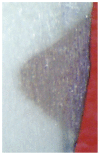
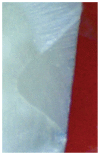
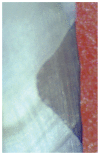
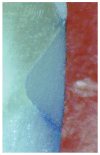
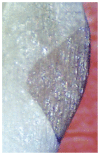
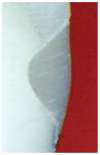
Similar articles
-
Microleakage of class V resin composites using various self-etching adhesives: an in vitro study.J Contemp Dent Pract. 2013 Jan 1;14(1):51-5. doi: 10.5005/jp-journals-10024-1269. J Contemp Dent Pract. 2013. PMID: 23579893 Clinical Trial.
-
Influence of flowable liner and margin location on microleakage of conventional and packable class II resin composites.Oper Dent. 2005 Jan-Feb;30(1):32-8. Oper Dent. 2005. PMID: 15765955
-
Comparison of Microleakage of Class V Cavities restored with the Embrace WetBond Class V Composite Resin and Conventional Opallis Composite Resin.J Contemp Dent Pract. 2017 Oct 1;18(10):867-873. doi: 10.5005/jp-journals-10024-2141. J Contemp Dent Pract. 2017. PMID: 28989122
-
Microleakage of four composite resin systems in class II restorations.SADJ. 2009 Nov;64(10):484-8. SADJ. 2009. PMID: 20306869
-
The effect of occlusal loading on the microleakage of class V restorations.Oper Dent. 2008 Mar-Apr;33(2):135-41. doi: 10.2341/07-49. Oper Dent. 2008. PMID: 18435186 Clinical Trial.
References
-
- Manhart J, Chen HY, Mehl A, Weber K, Nickel R. Marginal quality and microleakage of adhesive class V restorations. J Dent. 2001;29:123–130. - PubMed
-
- Schupbach P, Guggenheim B, Lutz F. Human root caries. J Oral Pathol Med. 1989;18:146–56. - PubMed
-
- Levitch LC, Bader JD, Shugars DA, Heymann HO. Non-carious cervical lesions. J Dent. 1994;22:195–207. - PubMed
-
- Lee WC, Eakle WS. Possible role of tensile stresses in the etiology of cervical erosive lesions of teeth. J Prosthet Dent. 1984;52:374–80. - PubMed
-
- Tyas MJ. The class V lesion: aetiology and restoration. Aust Dent J. 1995;40:167–70. - PubMed
LinkOut - more resources
Full Text Sources
